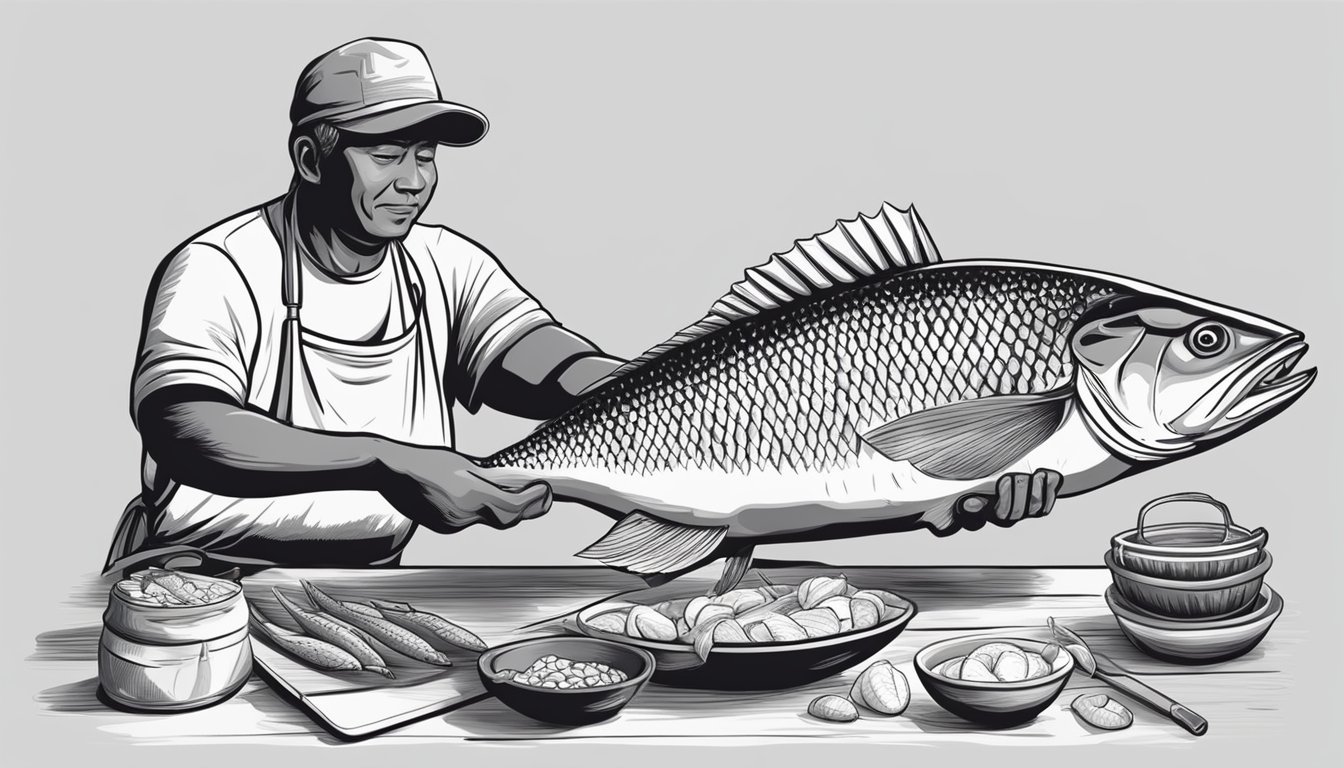Paco Fish
Exploring the Exotic Amazonian Delicacy
Paco fish, also known as pacu, is an intriguing culinary treasure from the vast biodiversity of the Amazon Basin. While it may not be a household name globally, this fish is a staple and a delicacy in its native region. Its taste and texture have often drawn comparisons to more familiar meats, with some even likening pacu ribs to traditional barbecued pork ribs (What wine goes well with pork ribs?) due to their appearance and flavor profile. The fish is commonly prepared either by grilling or oven baking, often glazed with rich barbecue sauce that complements its naturally subtle taste.
In the Peruvian Amazon, farming of pacu is advancing aquaculture practices, promoting sustainable livelihoods for local communities. The initiatives aim not only to provide an important food source but also to ensure conservation of the natural ecosystems around major reserves, such as the National Tambopata Reserve.
Given its culinary versatility, pacu has been embraced in Brazilian cuisine as well, where it's typically seasoned with a blend of garlic, oil, butter, chili pepper, and lemon to enhance its flavor. Often recommended to be served with white rice and paired with a dry white wine, pacu offers a distinctive gastronomic experience for those adventurous enough to try this Amazonian treat.
Origins and Habitat
The Pacu fish is an intriguing species native to the Amazonian Basin, primarily flourishing in the tropical freshwater ecosystems of South America.
Geographical Distribution
The Pacu fish predominantly inhabits the Amazonian rivers across countries such as Brazil, where they have adapted to the dynamic river environment. They are found in various water systems ranging from large rivers to floodplains.
Environmental Significance
In their Amazonian habitats, Pacu fish play a crucial role in the ecosystem as seed dispersers due to their vegetarian diet. This ecological service helps maintain the diversity of the rainforest. The varied temperature preferences of the species, typically between 22 and 28°C, also highlight their adaptation to the tropical climate of the region.
Biological Characteristics
Paco Fish, known scientifically as Piaractus brachypomus, is a sought-after species in the Amazon basin. Their unique characteristics and dietary habits make them an important part of the aquatic ecosystem.
Species and Classification
Piaractus brachypomus, commonly known as Paco Fish or the Red-bellied Pacu, belongs to the family Characidae. This family encompasses a diverse group of freshwater fish prevalent in the Amazon. The Paco's closest relatives include other pacus and piranhas, although they differ significantly in behavior and diet.
Unique Features and Diet
Distinguished by their robust body and red belly, Paco Fish can grow quite large, with some specimens reaching up to 88 cm in length and weighing up to 25 kg. They have a subtle yet crucial role in their habitats, often being seed dispersers due to their fruit-based diet. Their diet typically includes:
Fruits
Nuts
Seeds
This herbivorous diet differentiates them from their carnivorous piranha relatives. Pacu fish possess molariform teeth, which are well-adapted for crushing and grinding plant materials. The nutritional intake from their diet is essential for their growth and reproductive health.
Nutritional Profile
Pacu fish, an Amazonian delicacy, has a nutritional profile that makes it a noteworthy addition to the diet. This section examines the health benefits and iron content of this unique fish.
Health Benefits
Pacu fish are a source of numerous nutrients that contribute to overall health. They provide high-quality protein, essential for muscle repair and growth. Additionally, they contain omega-3 fatty acids, known for their positive effects on heart health and for reducing inflammation in the body.
Iron Content
The iron content in Pacu fish is significant, contributing to the dietary iron intake which is vital for the production of red blood cells. Iron plays a crucial role in transporting oxygen throughout the body and helps prevent anemia. Consuming Pacu fish can be beneficial especially for individuals who require higher iron in their diets.
Culinary Uses
Pacu fish, a staple in Amazonian cuisine, is celebrated for its versatility in various dishes ranging from traditional recipes to modern culinary adaptations. Its substantial, meaty ribs and tender flesh absorb flavors like oil, butter, garlic, and lemon, making it a desirable ingredient for diverse preparations.
Traditional Recipes
Patarashca: This time-honored method involves wrapping the pacu fish in leaves together with ingredients such as onions, chiles, and spices, then steaming the bundle to create a fragrant and flavorful dish. It's a technique that not only imparts aroma but also conserves the moisture of the fish, ensuring a tender texture.
Grilled Pacu: Pacu ribs are often seasoned and cooked over an open flame. A simple yet popular marinade for the fish includes:
Olive oil or another cooking oil
Minced garlic
Squeezed lemon juice
Salt and pepper for taste
Marinating the ribs in this mixture before grilling enhances the fish's natural flavors.
Modern Adaptations
Contemporary chefs have embraced pacu fish, introducing it into fusion cuisine. They often experiment with replacing more common fish in recipes with pacu, due to its adaptability.
Baked Pacu with Herb Butter: A modern twist on a classic preparation might include creating an herb butter with ingredients such as:
Unsalted butter
Finely chopped garlic
Lemon zest
A mix of fresh herbs (like parsley and dill)
Salt and freshly ground pepper
The pacu is then baked until flaky, allowing the herb butter to infuse the flesh with rich, aromatic flavors.
Whether served in traditional Amazonian dishes or as part of innovative new recipes, pacu fish offers a delightful experience for the palate, bridging the culinary gap between the ancient and the contemporary.
Cultural Significance
The Pacu fish, a cousin of the more notorious piranha, has grown to occupy a distinct place in the cultural fabric of the Amazonian region. Both revered and consumed, it has influenced local customs and even captured global interest as an exotic delicacy.
Local Customs
In the Amazonian basin, the Pacu fish is integral to the diets and traditions of indigenous communities. Known for their unique dentition resembling human teeth, Pacu are often grilled or baked, sometimes wrapped in banana leaves to infuse a subtle sweetness into their flesh. These methods of preparation have been passed down for generations, cementing the fish's role in festive and daily meals alike. Fishing for Pacu is also a time-honored skill among locals, who rely on the fish as a staple protein source.
In Bolivia, specifically, the Pacu constitutes a vital alternative to red meat, a staple in the landlocked nation's diet due to its lack of access to the sea. Here the fish promotes dietary diversity and provides essential nutrients. Despite the absence of a traditional fishing culture, the Bolivian reliance on Amazonian rivers for sustaining its food systems is evident in the popularity of the Pacu on tables throughout the country.
Global Influence
Internationally, the Pacu fish has found its way into the markets and restaurants of countries far from its Amazonian home. In Japan, renown for its seafood and innovative dishes, Pacu has emerged as an ingredient in upscale eateries, showcasing the versatility and appeal of Amazonian cuisine. The delicate yet meaty texture of the fish allows it to be a substitute for seafood favorites like lobster, offering a sustainable and freshwater alternative that aligns with the global trend towards responsible consumption.
Norwegian chefs have also experimented with Pacu, often driven by a curiosity to expand the range of sustainable seafood species enjoyed in Scandinavia. While it stands apart from traditional Norwegian fare, the introduction of Pacu aligns with the country's emphasis on preserving marine ecosystems and exploring alternative aquaculture practices.
By transcending its Amazonian roots, the Pacu has become a symbol of culinary exploration and cultural exchange, earning it a place of significance on the global gastronomic stage.
Conservation Efforts
Conservation efforts for Paco fish, also known as Paiche or Arapaima, are crucial to maintaining the delicate balance of the ecosystem in the Amazon and ensuring the species' long-term viability. These efforts focus on both sustainable practices and regulatory measures to protect this important species.
Sustainability Practices
In response to overfishing, sustainable aquaculture practices have been implemented to support the population of Paco fish. Fish farms, like the one installed in Inambari, Madre de Dios, are part of initiatives designed to create sustainable livelihoods and act as an important food source for local populations. These farms utilize carefully managed systems to breed the fish, mimicking natural conditions without the negative impacts of overfishing.
Key Sustainable Practices include:
Selective Breeding: Enhancing the stock without risking the native gene pool.
Controlled Harvesting: Ensuring that only a sustainable number of fish are caught.
Regulations and Restrictions
The introduction of regulations and restrictions helps to control the harvesting of Paco fish in the wild. Governments and conservation organizations collaborate to monitor fish populations and implement laws that limit the size and amount of fish that can be captured. These regulations are vital for the stability of the species and also for the health of the entire Amazonian aquatic ecosystem.
Major Regulations include:
Fishing Quotas: Limits on the number of fish that can be legally harvested.
Size Restrictions: Minimum size requirements to prevent the taking of juvenile fish.
Risks and Controversies
In the world of exotic delicacies, the Paco fish has generated its share of discussions. Two primary concerns impact its consumption: potential toxicity and the chances of misidentification, which can lead to serious health risks.
Toxicity Concerns
Paco fish, also known as Piaractus brachypomus, does not inherently produce toxins. However, its relative, the Puffer Fish, is renowned for containing dangerous levels of tetrodotoxin — a potent neurotoxin. Harvesters and consumers of Paco must stay vigilant to avoid confusing it with toxic species.
Although Paco does not carry tetrodotoxin, any consumed fish can pose a health risk if it accumulates environmental toxins from polluted waters. Preparing and serving Paco necessitates strict adherence to safety protocols to mitigate the chances of foodborne illness.
Misidentification Issues
Misidentifying fish species can have life-threatening consequences, particularly when dealing with species similar to the lethally toxic Fugu, or Puffer Fish. Due to their physical similarities, confusion can sometimes occur, significantly raising the stakes of consumption.
Paco: Toxin Risk - None inherent; Physical Traits - No distinctive toxic traits
Puffer Fish: Toxin Risk - High (Fugu); Physical Traits - May contain tetrodotoxin in organs
Misidentification leads to risks that are not to be taken lightly; Fugu chefs require years of rigorous training to prepare Puffer Fish safely. It is essential for consumers to purchase Paco from reputable sources to ensure the safety of their meal and prevent severe health risks associated with mistakenly consuming toxic fish variants.
Preparation Techniques
When preparing Paco fish, commonly known as Arapaima or Paiche, chefs employ various cooking methods and serving suggestions to highlight the fish's natural flavors. The size and texture of Paco fish make it suitable for several culinary applications, ensuring a versatile experience on the plate.
Cooking Methods
Grilling: Paco fish's firm flesh grills beautifully, making it a prime candidate for high-heat cooking over an open flame. Chefs often season the steak-like cuts with bold spices before searing to impart a smoky flavor.
Roasting: Enclosing the fish in parchment with a medley of vegetables or plantains allows it to steam gently, preserving its moisture and mingling flavors.
Casserole: Incorporating chunks of Paco fish into rice or flour-based casseroles allows its subtle taste to shine alongside other ingredients like chicken, bacon, or squid.
Serving Suggestions
Rice Complementary: Paco fish is often served alongside rice flavored with herbs and spices, similar to the traditional Peruvian dish Juane, enhancing the dining experience with its seasoned accompaniment.
With Vegetables: Steamed or grilled cabbage and plantains are common pairings that complement the fish's texture and can be spiced with hot sauce or peanuts for a kick.
Sauce Pairings: A light drizzle of uni (sea urchin) sauce or a salsa featuring bananas and hot sauce offer a sweet and spicy counterbalance to the mild Paco fish flavors.
Conclusion
The pacu fish, often marketed under the Peruvian name "Paco," is a staple in the Amazonian diet and increasingly gaining attention worldwide. With its rich, white flesh and versatility in local cuisines, it has become an ecologically significant alternative to the over-fished species in the region.
Aquaculture Efforts: The efforts to farm pacu, such as those practiced near major conservation areas like the Tambopata Reserve, are promising steps toward sustainable food sourcing and enhancing local livelihoods.
Nutritional Value: Pacu provides substantial nutritional benefits, and its cultivation could help address food security concerns.
Economic Potential: Its growing popularity could foster new economic opportunities for Amazonian communities.
Environmental Impact: Even as pacu supports local economies, careful management of its farming is crucial to prevent potential ecological imbalances in its non-native habitats.
Ultimately, while the fish offers numerous benefits, continued research and sustainable practices will be key to maximizing its positive impact on both the environment and the communities that depend on it.










